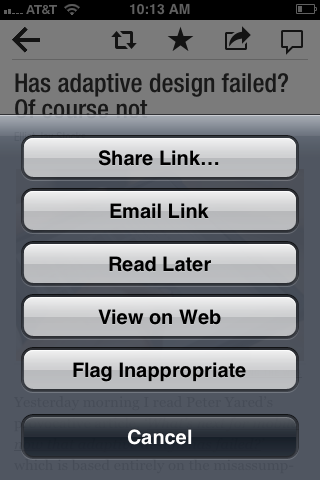Share buttons may irritate us at the moment, but they’ll continue to mature in the way they are implemented and they’ll eventually become obsolete due to device-level capabilities.
 Oliver Reichenstein of Information Architects recently wrote a thoughtful and provocative article titled “Sweep the Sleaze”. Despite the broad strokes and firm tone of his piece, I’m very pleased to see a well thought out challenge to the often mindless and trend-rabid implementation of social sharing buttons. I think it’s an important addition to the discussion around best practices for social media. His general thesis brings the dialogue back to where it should have been all along – How can we tactfully implement sharing as part of a user-centered design process?
Oliver Reichenstein of Information Architects recently wrote a thoughtful and provocative article titled “Sweep the Sleaze”. Despite the broad strokes and firm tone of his piece, I’m very pleased to see a well thought out challenge to the often mindless and trend-rabid implementation of social sharing buttons. I think it’s an important addition to the discussion around best practices for social media. His general thesis brings the dialogue back to where it should have been all along – How can we tactfully implement sharing as part of a user-centered design process?
As Reichenstein indicated, each social service button has its own unique UX and flow. They also have their own set of pros and cons as they relate to improving the engagement of a target audience. In addition, they also share some general attributes that can either work for or against you, in terms of interaction and site performance. For example, the article highlights the general implications when it comes to displaying the number of times something was shared. You generally either look like a loser with a low count, or an over-shared meme, except for that fleeting period of time when the count is neither too low or too high.
In order to do something that’s better and more intelligent, content designers have to stop thinking in terms of a “bank of buttons” model. They must start exploring the features and flow of each individual sharing button as it relates to the interaction narratives they desire for their users.
There’s a great quote from Smashing Magazine in Reichenstein’s article. It points out a fatal flaw in Facebook’s “Like” button UX, that caused them to pull it from their site. However, if you ran a similar user study examining a properly implemented Twitter button (which pops a window with editable pre-populated text including the article title, a link and the @username), I’m willing to barter that many users do appreciate the lack of ‘friction’ in comparison to a copy-paste model of tweeting an article. In addition, when such an implementation automatically assists a user in correctly identifying the twitter handle of the author, it helps to preserve the provenance of the content as it circulates.
So does this mean that sites do want a Twitter button, but don’t want a Facebook “Like” button? No, there’s no magic formula. You have to do the hard work of mapping out how each bit of functionality fits into your particular site or service. I think that’s ultimately the point Reichenstein makes. Don’t implement social sharing as a knee-jerk reaction to a trend, design it into your web/application flow the same way you should be adding any other feature.
Mobile OS and UI-Level integration of sharing tools may eventually render this all a non-issue. Content providers have been using share buttons as a stop-gap measure to compensate for difficulties related to expanding the reach of their content. Our devices, operating systems and browser UIs are improving at a rapid clip. Flipboard is just one example of an innovative app that eliminates the need for in-content sharing buttons. I think we can look forward to a day when these buttons will no longer be cluttering the display of our content and applications – not because people don’t want quick & easy ways to share content, but because the interface to such a capability will become ubiquitous and transparent.
